26 4.2 Vector Addition and Subtraction
Summary
- Define and apply the rules of vector addition and subtraction.
Vectors in One Dimension
A vector is a quantity that has magnitude and direction. Displacement, velocity, acceleration, and force, for example, are all vectors. In one-dimensional, or straight-line, motion, the direction of a vector can be given simply by a plus or minus sign. In the horizontal axis, + corresponds to movement to the right and – corresponds to movement to the left. In the vertical axis, + corresponds to upward movement and – corresponds to downward movement.
If all of the vectors are acting along the horizontal axis (x), vectors can be added or subtracted together like regular numbers. If all of the vectors are acting along the vertical axis (y), vectors can be added or subtracted together like regular numbers. For example, if a person runs 8 m to the right stops and then runs 10 m to the right, their final displacement is (+8m +10m) 18m. If the same person then walked 13 m to the left, the final displacement would be: +18m – 13 m = +5m.
If one of the vectors is acting along the horizontal axis (x) and one is acting along the vertical axis (y), you will have to use a different strategy, suitable for adding or subtracting vectors in two dimensions (x and y).
Vectors in Two Dimensions (One vector acting in y, one in x)
In two dimensions (2-d), we specify the direction of a vector relative to some reference frame (i.e., coordinate system), using an arrow having length proportional to the vector’s magnitude and pointing in the direction of the vector.
Figure 1 shows such a graphical representation of a vector, using as an example the total displacement for the person running in a city considered in the previous section. The person ran 9 blocks east and 5 blocks north and we want to know his final displacement. We shall use the notation that a symbol with an arrow over it, such as
VECTORS IN THIS TEXT
In this text, we will represent a vector with an arrow over a symbol. For example, we will represent the quantity force with the vector
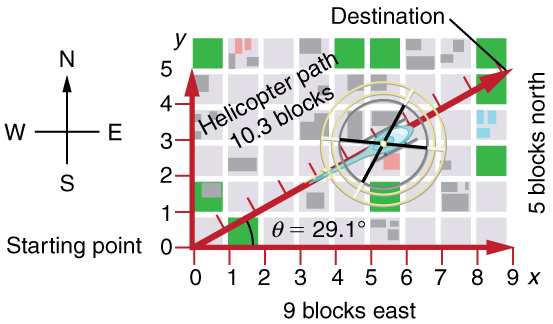
Vector Addition: Tip-to-Tail Method
The tip-to-tail method is a graphical way to add two vectors, when one is vertical and the other horizontal. It is described in Figure 2 below and in the steps following. The tail of the vector is the starting point of the vector, and the tip of a vector is the final, pointed end of the arrow.
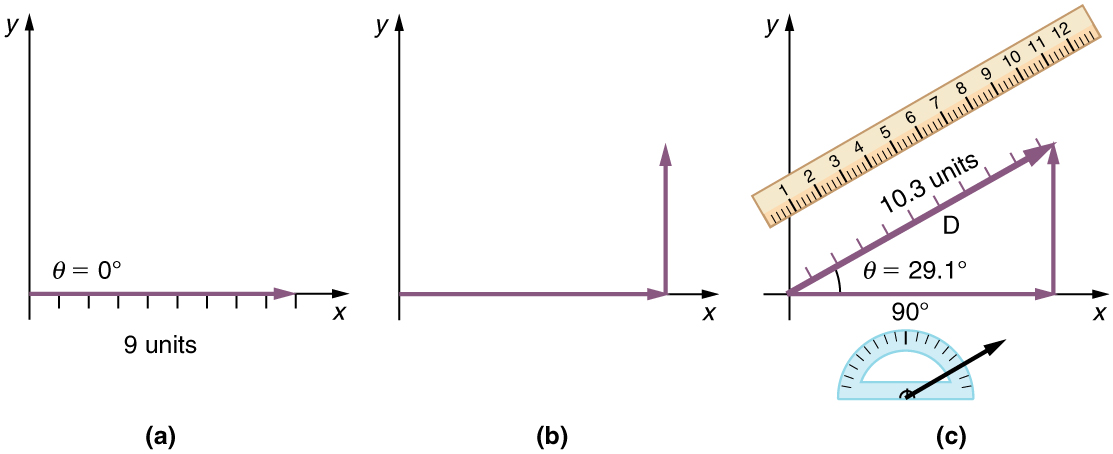
Step 1. Draw an arrow to represent the first vector (9 blocks to the east) using a ruler.
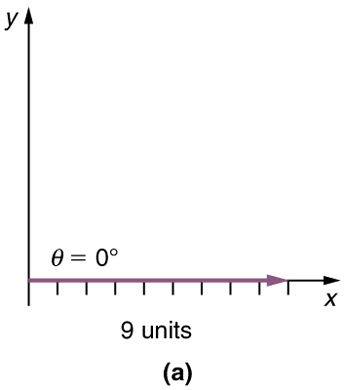
Step 2. Now draw an arrow to represent the second vector (5 blocks to the north). Place the tail of the second vector at the tip of the first vector.
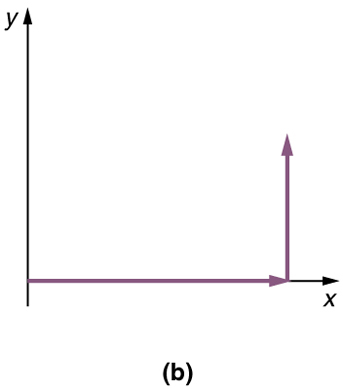
Step 3. If there are more than two vectors, start by adding all the horizontal vectors together to have one resultant x vector and add all the vertical vectors together to have one resultant y vector. Use the two resultants in the tip-to-tail method.
Step 4. Draw an arrow from the tail of the first vector to the head of the last vector. This is the resultant, or the sum, of the other vectors.
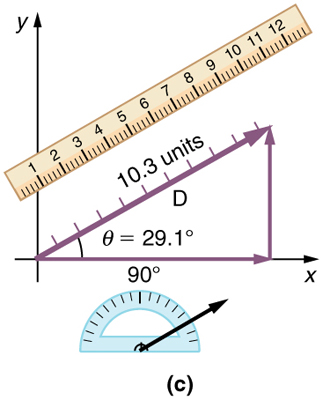
Step 5. To get the magnitude of the resultant, we will use the Pythagorean theorem to determine the length of the hypotenuse of this newly formed right angle triangle. (D = √x2+y2)
Step 6. To get the direction of the resultant, we will use trigonometric relationships.
tan θ = opposite/adjacent
tan θ = y/x
Finding the vectors components
In the examples above, we have been adding vectors to determine the resultant vector. In many cases, however, we will need to do the opposite. We will need to take a single vector and find what other vectors added together produce it. In most cases, this involves determining the perpendicular components of a single vector, for example the x– and y-components, or the north-south and east-west components.
For example, we may know that the total displacement of a person walking in a city is 10.3 blocks in a direction 29.0° north of east and want to find out how many blocks east and north had to be walked. This method is called finding the components (or parts) of the displacement in the east and north directions, and it is the inverse of the process followed to find the total displacement. It is one example of finding the components of a vector. You can draw the components (x and y) of the vector and the resultant (hypothenuse) as a right-angle triangle and use your knowledge of trigonometry to solve for the length of the components (x and y).
Vector in Two-Dimensions (Adding vectors acting at angles)
More realistically, you will have to add vectors that are not acting perfectly along the horizontal axis or the vertical axis. If you have to add vectors that are acting at angles and that are composed of a horizontal component and a vertical component. The preferred strategy in this case, would be to break the vectors down into their horizontal and vertical components. You can then add all of the horizontal components together and all the vertical components together to end up with two vectors acting perfectly along each axis. Use the tip-to-tail method to reconstruct your final results vector. Remember that your final answer should have a magnitude and direction (an angle in this case).
Summary
- The method of adding vectors
- The tip-to-tail method of adding vectors involves drawing the first vector on a graph and then placing the tail of each subsequent vector at the head of the previous vector. The resultant vector is then drawn from the tail of the first vector to the head of the final vector.
Conceptual Questions
1: Which of the following is a vector: a person’s height, the altitude on Mt. Everest, the age of the Earth, the boiling point of water, the cost of this book, the Earth’s population, the acceleration of gravity?
2: Give a specific example of a vector, stating its magnitude, units, and direction.
3: What do vectors and scalars have in common? How do they differ?
4: Two campers in a national park hike from their cabin to the same spot on a lake, each taking a different path, as illustrated below. The total distance traveled along Path 1 is 7.5 km, and that along Path 2 is 8.2 km. What is the final displacement of each camper?
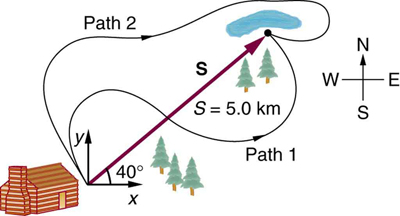
5: Suppose you take two steps A and B (that is, two nonzero displacements). Under what circumstances can you end up at your starting point? More generally, under what circumstances can two nonzero vectors add to give zero? Is the maximum distance you can end up from the starting point A+B the sum of the lengths of the two steps?
6: Explain why it is not possible to add a scalar to a vector.
7: If you take two steps of different sizes, can you end up at your starting point? More generally, can two vectors with different magnitudes ever add to zero? Can three or more?
Problems & Exercises
Solve these problems.
1: Suppose you walk 18.0 m straight west and then 25.0 m straight north. How far are you from your starting point, and what is the compass direction of a line connecting your starting point to your final position? (If you represent the two legs of the walk as vector displacements $\vec{\text{A }}$ and $\vec{\text{B}}$, as in Figure 7, then this problem asks you to find their sum $\vec{\text{R}}=\vec{\text{A}}+\vec{\text{B}}$.)
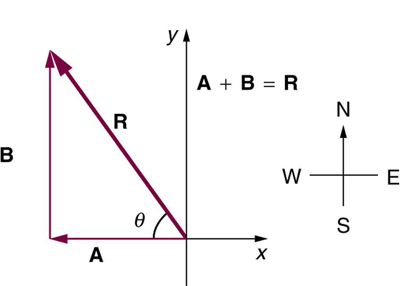
2: Suppose you first walk 12.0 m in a direction 20° west of north and then 20.0 m in a direction 40.0° south of west. How far are you from your starting point, and what is the compass direction of a line connecting your starting point to your final position?
Glossary
- component (of a 2-d vector)
- a piece of a vector that points in either the vertical or the horizontal direction; every 2-d vector can be expressed as a sum of two vertical and horizontal vector components
- commutative
- refers to the interchangeability of order in a function; vector addition is commutative because the order in which vectors are added together does not affect the final sum
- direction (of a vector)
- the orientation of a vector in space
- tip (of a vector)
- the end point of a vector; the location of the tip of the vector’s arrowhead; also referred to as the “tip”
- tip-to-tail method
- a method of adding vectors in which the tail of each vector is placed at the head of the previous vector
- magnitude (of a vector)
- the length or size of a vector; magnitude is a scalar quantity
- resultant
- the sum of two or more vectors
- resultant vector
- the vector sum of two or more vectors
- scalar
- a quantity with magnitude but no direction
- tail
- the start point of a vector; opposite to the head or tip of the arrow
Solutions
Problems & Exercises
2:

